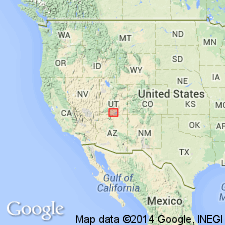
- Usage in publication:
-
- Escalante Member
- Modifications:
-
- Named
- Dominant lithology:
-
- Sandstone
- AAPG geologic province:
-
- Paradox basin
Summary:
Pg. 19-24. Escalante Member, upper member of the Entrada Sandstone of the San Rafael Group. Consists of gray, green, red, and white massive to cross-bedded sandstone. Thickness at type is 85 m; ranges from 29 to 85 m. [Measured section nearest to Escalante at Pine Creek, 7 mi north of Escalante, in sec. 13, T. 34 S., R. 2 E. There, Escalante Member is 225 to 285 feet thick and described as a medium- to very fine-grained, poorly sorted, angular to well-rounded, friable (poorly cemented with calcite) to massive quartzose sandstone. Called the gray and green sandstone facies. Grades into red cross-bedded facies 35 miles southeast of Pine Creek.] Unconformably overlies the Cannonville Member (new) of the Entrada Sandstone; unconformably underlies the Henrieville Sandstone or the Salt Wash Member of the Morrison Formation. [At Pine Creek, unconformably underlies Summerville Formation.] Age is Middle Jurassic. [Report includes measured sections, cross sections.]
Type locality: near Escalante, in T. 35 S., R. 3 E., Garfield Co., UT. Named for rocks in vicinity of Escalante [probably Escalante Rim in T. 36 S., R. 3 and 4 E., and Pine Creek in T. 34 and 35 S., R. 2 and 3 E.], Garfield Co., UT, Paradox basin.
[Discrepancies: (1) US geologic names lexicon (USGS Bull. 1520) and GNU records (Menlo GNULEX; USGS DDS-6) indicate authors, in this report, formally propose the Escalante Member --this is presented here. GNU records (USGS DDS-6; Denver GNULEX) indicate authors, in this report, do not formally propose the Escalante Member. (2) USGS Bull. 1520 indicate authors, in this report, assigned a Middle Jurassic age to the Escalante --this is presented here. Denver GNULEX indicates authors, in this report, did not assign any age to the Escalante, but age is presumed to be Middle Jurassic. Menlo GNULEX indicates authors, in this report, assigned a Late Jurassic age to the Escalante. (3) USGS Bull. 1520 and Menlo GNULEX state the Escalante Member "unconformably underlies the Henrieville Sandstone or the Salt Wash Member of the Morrison Formation." Denver GNULEX states the Escalante Member "unconformably underlies Summerville Formation at Pine Creek." --unresolved.]
Source: US geologic names lexicon (USGS Bull. 1520, p. 97-98); GNU records (USGS DDS-6; Menlo GNULEX, supplemental information (in brackets) from Denver GNULEX).
For more information, please contact Nancy Stamm, Geologic Names Committee Secretary.
Asterisk (*) indicates published by U.S. Geological Survey authors.
"No current usage" (†) implies that a name has been abandoned or has fallen into disuse. Former usage and, if known, replacement name given in parentheses ( ).
Slash (/) indicates name conflicts with nomenclatural guidelines (CSN, 1933; ACSN, 1961, 1970; NACSN, 1983, 2005, 2021). May be explained within brackets ([ ]).

